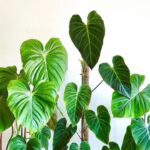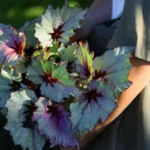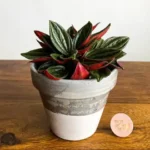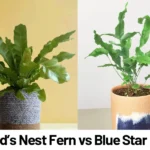Introduction
If you’re a fan of striking foliage and unique houseplants, Aglaonema pictum tricolor might just be the crown jewel of your indoor garden. Commonly known as the “camouflage plant” due to its stunning variegated leaves, this rare tropical beauty is prized by collectors and beginner hobbyists alike.
In this comprehensive care guide, we’ll explore everything you need to know about Aglaonema pictum tricolor, from its botanical background to practical, science-backed care tips. Whether you’re just starting with indoor plants or looking to refine your existing setup, you’ll find actionable insights on lighting (measured in lux), watering, humidity, and more.
Botanical Background
Scientific Classification and Origin
- Botanical name: Aglaonema pictum tricolor
- Family: Araceae (Aroid family)
- Native range: Highland rainforests of Sumatra and other parts of Indonesia
- Type: Wild species with natural variegation, not a hybrid
This species was first described in the botanical records during 19th-century explorations of tropical Asia. Its military-camouflage pattern of three shades of green has made it a sought-after ornamental species in both botanical gardens and private collections worldwide.
Lighting Conditions (Measured in Lux)
Aglaonema pictum tricolor prefers moderate, consistent lighting and can suffer under excessive brightness or deep shade. Here’s how to dial in the perfect light levels:
Ideal Light Intensity
- Optimal: 4,000–6,000 lux (bright indirect light)
- Borderline low-light tolerance: 2,000–3,000 lux – expect slower growth and reduced variegation
- Minimum survival threshold: ~1,000 lux – survival possible but with potential legginess or yellowing
Direct sun (>10,000 lux), especially for extended periods, can scorch the delicate foliage. Ideally, place the plant near an east-facing window with filtered light or a few feet back from a south- or west-facing window.
Grow Lights
Grow lights are extremely helpful if natural light is insufficient. Use full-spectrum LED grow lights rated between 2,000–4,000 lux during a 10–12 hour on/off cycle. Be sure to position the light about 12–18 inches above the plant for best results.
Watering Schedule by Season and Conditions
This plant prefers moderately moist soil but is sensitive to overwatering due to its natural growth in well-draining forest floor habitats.
Watering Frequency
- Spring/Summer (Active Growth): Water every 7–10 days, or when the top 3–4 cm of soil feels dry.
- Autumn/Winter (Dormancy): Water every 14–18 days, depending on light and heating conditions.
Other Factors Influencing Water Needs:
- Pot size: Small (≤10 cm diameter) pots dry out faster — check moisture every 5–7 days
- Humidity: High humidity (above 70%) slows soil drying — adjust watering intervals accordingly
- Container material: Terra cotta dries out faster than plastic or ceramic pots
Always drain excess water and avoid letting the plant sit in a saucer of water. Root rot is a common killer of this species in cultivation.
Temperature and Humidity Ranges
Ideal Range
- Temperature: 18–27°C (64–81°F)
- Humidity: 60–80%
Aglaonema pictum tricolor thrives in the warm, moist air similar to its native rainforests. While it tolerates average room humidity (>45%), growth is noticeably better at levels above 60%, especially during winter when indoor heating dries the air. Consider using a humidifier or pebble tray for increased humidity.
Minimum Tolerance
- Temperature: 15°C (59°F) – lower levels can stress the plant or cause leaf damage
- Humidity: Below 40% – may lead to crisping leaf edges or slowed growth
Common Problems and Solutions
Although generally easy-going, this plant can present a few challenges. Here’s how to troubleshoot them:
Yellowing Leaves
Cause: Overwatering or poor drainage
Solution: Check soil moisture with a moisture meter (aim for readings of 3–4 on a 10-point scale before watering). Ensure the potting mix includes perlite and orchid bark for aeration.
Root Rot
Cause: Prolonged saturation of soil
Solution: Remove plant, trim off mushy or black roots, and repot in fresh, sterile substrate with better drainage. Use a pot with drainage holes only.
Browning Leaf Tips
Cause: Low humidity or salt build-up from tap water
Solution: Increase ambient humidity and use filtered or rainwater for irrigation.
Faded Leaf Variegation
Cause: Inadequate light
Solution: Move the plant closer to a bright, filtered light source (~4,000–6,000 lux) or install a grow light.
Pest Alerts
- Mealybugs: Look for cottony masses on stems and leaf axils
- Spider mites: Fine webbing and stippled foliage
Treat infestations with insecticidal soap or neem oil, and improve air movement to discourage pests.
Safety Notes
Aglaonema pictum tricolor, like others in the Araceae family, contains calcium oxalate crystals. This substance is toxic if ingested by pets or humans, and can cause irritation to the mouth, throat, and digestive tract.
Safety Tips:
- Keep the plant out of reach of pets and young children
- Wear gloves when pruning or repotting to avoid skin irritation
- If ingested, seek veterinary or medical help immediately
Real-Life Plant Care Tricks
Success with this plant often comes down to consistency and attention to microclimate. Here’s what experienced growers recommend based on tested routines:
- Use a hygrometer: Monitor room humidity near your plant — digital hygrometers are inexpensive and reliable.
- Rotate weekly: Turn the pot a quarter turn weekly to ensure even growth and light exposure.
- Surface mulch: Add a thin layer of orchid bark or sphagnum moss to maintain surface humidity and soil moisture without rot.
- Flush the soil: Every 4–6 weeks, water deeply and allow it to fully drain to remove accumulated salts.
- Cover for humidity: In low-humidity homes, place the plant inside a glass cabinet or plastic storage tote that’s been converted into a DIY greenhouse.
Conclusion
Aglaonema pictum tricolor is more than just a showpiece—it’s a living slice of the Sumatran cloud forest that can thrive in your home with the right care. By providing proper lighting (4,000–6,000 lux), managing watering carefully based on season and environmental factors, and maintaining warmth and humidity, you’ll be rewarded with lush, camouflaged foliage year-round.
Attention to detail helps this rare plant flourish, but don’t be intimidated—it’s surprisingly forgiving once established. With this guide as your reference, even beginner gardeners can confidently grow and enjoy one of the world’s most captivating aroids.
References
- Boyce, P. C. (2009). The genus Aglaonema Schott (Araceae: Aglaonemateae) in Peninsular Malaysia, including a new species. Botanika Helvetica, 119(1), 63–76. https://doi.org/10.1007/s00035-009-0057-0
- California Master Gardener Handbook (2nd ed.). (2014). University of California Agriculture and Natural Resources. ISBN: 978-1-60107-857-7
- Encyclopedia of Indoor Plants. (2020). Royal Horticultural Society. https://www.rhs.org.uk








